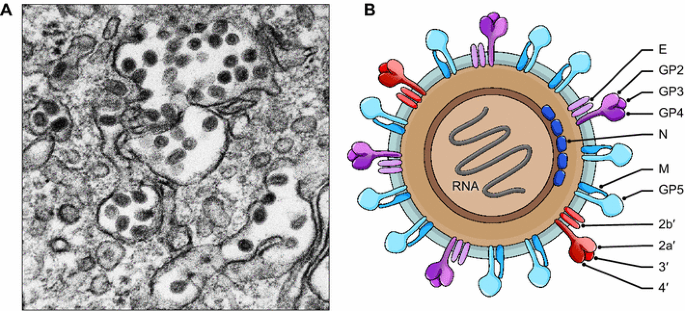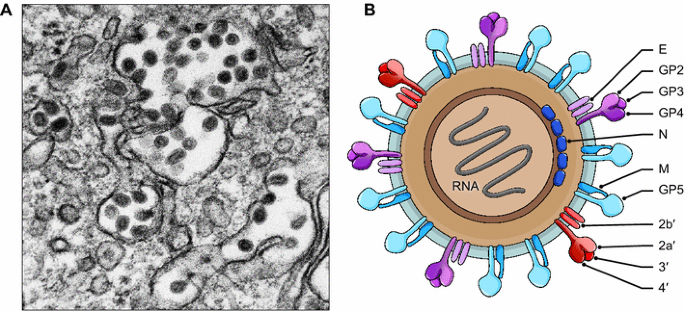In recent years, the advancement of high throughput sequencing technologies has revolutionized our understanding of the virosphere, allowing for the identification of a diverse array of viruses. With improved viral surveillance, scientists have been studying the viral communities associated with the human-animal interface in the Amazonian region. A recent study published in the journal Viruses has shed light on the discovery of a novel Arterivirus in rodents, raising concerns about potential viral spillover threats.
The International Committee on Taxonomy of Viruses (ICTV) recognizes metagenomics as a valuable source of biological information for viral classification. Since the 2014 ICTV release, the Arteriviridae family, belonging to the order Nidovirales, has shown a six-fold increase in species content. Currently, the family comprises thirteen genera, 11 subgenera, and 23 species. Among these, the Variarterivirinae and Heroarterivirinae subfamilies have been associated with rodents.
Arteriviruses are characterized by their spherical shape, enveloped structure, and positive-sense, single-stranded RNA genomes. Despite slight variations in the open reading frame (ORF) among species within the Arteriviridae family, conserved domains such as ORFs 1a (3C-like protease-3CLpro) and 1b (RNA-dependent RNA polymerase-RdRp) are used as standard markers for genetic distance indexes and taxonomic differentiation.
The Identification of Novel Arterivirus in Amazonian Rodents
Arterivirids refer to non-human mammalian viruses that infect a wide range of hosts, including rodents, shrews, horses, hedgehogs, and possums, but have not yet been assigned to any specific species. While several arteriviruses like the simian hemorrhagic fever virus (SHFV) and equine arteritis virus (EAV) pose significant veterinary concerns, the lactate dehydrogenase elevating virus (LDV) infects mice and belongs to the Arteriviridae family.
Recent metagenomic studies have primarily reported rodent arteriviruses with origins in Africa, Asia, or Europe, collected from regions like Ukraine, China, Cameroon, Mozambique, and Tanzania. However, the current study focuses on the discovery of a novel arterivirus from tissue samples collected in Santa Bárbara do Pará, Brazil, providing unique insights into the viral diversity in the Amazon.
As part of a broader surveillance study exploring viral communities associated with wild mammals at the human-animal interface, the researchers collected tissue samples from 39 mammals, including 12 rodents, 18 marsupials, and 9 chiropterans, in forested areas near human habitations and agricultural practices. Blood, serum, and tissue samples were collected from captured animals, and rodents’ tissue samples were pooled for analysis.
The researchers identified Oecomys sp., a rodent species, based on morphological characteristics. Although the rodents did not exhibit any apparent signs of illness, the study revealed an almost complete genome of a novel arterivirus within the Arteriviridae family. The genomic sequence demonstrated the presence of ORF1a and ORF1b, which are crucial in arterivirid genomes, along with the expression of non-structural proteins (NSPs) and structural proteins (envelope, glycoproteins, membrane, and nucleocapsid).
Furthermore, through phylogenetic analysis, the novel arterivirus, tentatively named Oecomys arterivirus 1 (OAV-1), was placed in the Variarterivirinae subfamily with high support. The phylogenetic analysis indicated that OAV-1 occupied the most basal branch in the clade of porcine and rodent arterivirids, highlighting its unique evolutionary position. Despite slight variations in the genetic distance between OAV-1 and other members of the Variarterivirinae subfamily, it was determined that OAV-1 represents a distinct clade within the subfamily.
The study further characterized OAV-1 by analyzing its amino acid and nucleotide sequences. These analyses revealed a high level of divergence between OAV-1 and other arteriviruses, suggesting its potential classification as a new genus within the Variarterivirinae subfamily. The researchers highlighted the need for further surveillance studies to better understand the diversity and coevolutionary patterns of the Arteriviridae family in the Amazon.
Implications for Taxonomic Classification and Public Health
The discovery of novel arteriviruses, such as OAV-1, poses challenges to the current taxonomic classification of the Arteriviridae family. As non-human viruses, arteriviruses have traditionally received less attention in terms of their impact on wildlife and livestock. However, the findings of this study emphasize the significance of understanding these viruses, particularly in the context of the human-animal interface.
Arteriviruses can potentially undergo spillover events, where they cross the species barrier and infect humans or domestic animals. Given the increasing contact between domestic and wild species in the Amazon region, the risk of viral spillover becomes a critical concern. Therefore, conducting comprehensive surveillance studies is crucial for identifying and monitoring potential viral threats.
The identification of OAV-1 in the Brazilian arboreal rice rat, Oecomys paricola, highlights the importance of studying host-virus interactions and their role in disease transmission. Understanding the natural hosts of viruses is essential for predicting and preventing future spillover events. In this case, Oecomys paricola serves as a reservoir for OAV-1, emphasizing the need to study the ecological factors contributing to viral persistence and transmission dynamics.
Furthermore, the presence of a novel arterivirus in the Amazon region raises questions about the broader diversity of viruses in this unique ecosystem. The Amazon rainforest is known for its rich biodiversity, and the discovery of OAV-1 suggests that there may be other yet-unidentified viruses circulating among the diverse wildlife populations. Investigating the virome of the Amazon and studying the interactions between viruses, hosts, and the environment can provide valuable insights into viral ecology and aid in early detection and response to potential outbreaks.
The identification of a novel rodent-borne arterivirus, OAV-1, in the Amazonian region highlights the importance of viral surveillance and understanding the diversity of viruses at the human-animal interface. This discovery challenges the current taxonomic classification and emphasizes the need for further studies to unravel the evolutionary patterns and potential threats associated with the Arteriviridae family.
The study underscores the significance of conducting comprehensive surveillance to monitor emerging viruses and their potential for spillover events. By studying the natural hosts, ecological factors, and transmission dynamics, scientists can gain valuable insights into preventing and mitigating the risks posed by novel viruses.
The Amazon rainforest, with its vast biodiversity, serves as a hotspot for viral discovery, and future research should continue to explore the virome of this unique ecosystem. Understanding the intricate relationships between viruses, hosts, and the environment will contribute to our preparedness and response strategies for emerging viral threats, both within the Amazon region and beyond.

